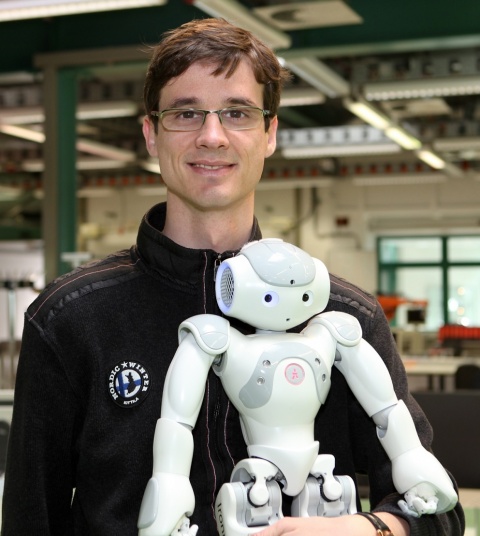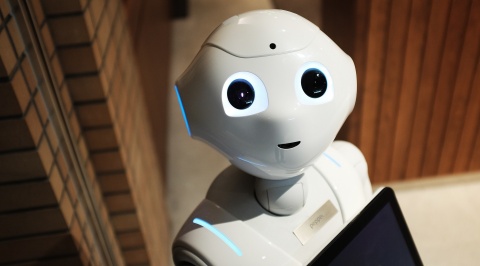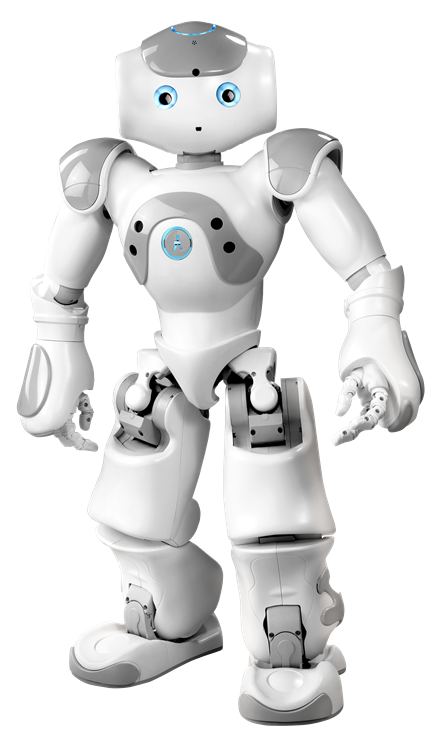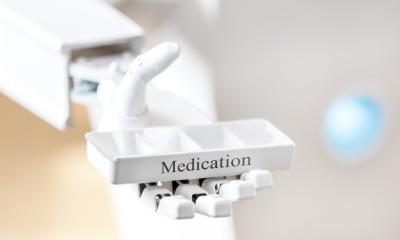Interview • New technologies
Robots in medicine: Weak knees and hard facts
Interview: Lena Petzold
Although robotics is now an established arm of medical technology – with the Da Vinci surgical system a trailblazer – many basic issues need to be resolved before nurse Robot can report for the morning shift in a ward. Surprisingly, among the major problems is the fact that a robot becomes a bit weak at the knees quite easily, explained Mathias Hofmann, researcher at the Robotics Research Institute at Technical University Dortmund, Germany, during an IVAM Microtechnology Network conference. Since centre-forward Robot and nurse Robot are closely related, we spoke with the developer of soccer robots about current progress.
Are service robots already put to use in medical procedures?

Service robots in Germany are still quite rare. The robotics industry is new and very few companies offer products suitable for daily use – primarily because a number of basic problems remain to be solved. The developers must go back to the drawing board and deal with functions such as language recognition and context awareness. If they don’t work properly in a robust and stable system, there will be no marketable products. Service robots, unlike precision systems in the OR, have to perform tasks autonomously – they are much more than a surgeon’s extended arm.
Where can service robots be used?
One thing remains clear: robots will never be able to replace clinical staff
Matthias Hofmann
They can be used in many areas: obviously, they can monitor and help patients, but they also can bridge waiting times and take over administrative tasks. Theoretically, a robot can perform any task with a low degree of autonomy. In the hospital or the waiting room a robot can entertain patients by playing games with them. Robots can “man” the reception desk – collect data or answer routine questions. In the future, robots will also be used to convey information on procedures, or to help children overcome their fear of surgical intervention or certain therapies. Robots might as well monitor the hospital for emergencies and alert the staff. Furthermore, the use of robots is being tested in specific therapies aimed at addiction patients or autistic people. Having said that, one thing remains clear: robots will never be able to replace clinical staff.
Then why waste energy on developing service robots?

The major advantage of service robots is that they relieve staff workload. With their very specific skills, robots are well suited to perform repetitive tasks. In 2014, “Pepper” was introduced, a robot with humanoid features, which, to a certain degree can interpret human emotions and respond appropriately. It is available 24/7 and never under pressure.
Which technical challenges need to be overcome?
On the technical side, a number of things remain to be done. Advanced recognition and language understanding is a highly complex process. Language, with its ambivalences and double meanings, is extremely difficult to process – as most people would confirm who have ever used an online translation system. Just like a human being, a robot needs to hear and record language, convert it phonetically into words and respond to it on the cognitive level. For a machine to perform those semantic processes and respond to nuances is much more difficult than for a human. Context awareness is another issue: the ability to recognise the environment and adjust the behaviour accordingly. Last but not least, the hardware has to be particularly sturdy – as we can see in soccer robotics every day.
Short, quick movements, as necessary on a football pitch, put strain on robot joints. This can be seen in this video of a match "Nao Devils" (blue / TU Dortmund) v. "DAInamite" (pink / TU Berlin).
Source: Youtube/Ascii6971
What problems are you currently trying to tackle?

We are working on several issues. As a football player, and as a robot, you have to be able to recognise your surroundings; you have to orient yourself; communicate with your team mates, make split-second decisions and move your body accordingly. For our research we use NAO, a two-legged humanoid robot that is 58 cm tall and equipped with two cameras, four microphones and speakers as well as several sensors – for example four ultrasound and eight pressure sensors. Just like its human counterpart a robot needs a sense of equilibrium, tactile sense and muscle sense. Under stress the robot’s joints run hot and it literally gets weak at the knees. Consequently, NAO needs a system that prevents it from overheating, so to speak.
This is one of the crucial challenges: developing robust systems. In a lab – or on our in-house soccer pitch – the robots tend to function pretty nicely. But, take them out of the lab and things get tricky: the transfer performance is still inadequate. On a smooth surface, NAO can walk without a problem, but what happens when there’s carpet on the floor or, even worse, steps? Camera settings are another headache: when light incidence changes, the perception of the robot changes. In well-lit rooms this is not so much of a problem, but a service robot also has to function when the light is dimmed or in the dark.
Beyond technical challenges, are there others?
Indeed, the legal and ethical obstacles are high. Should robots be allowed at all to act autonomously and take on responsibilities? Take the example above – robots that provide medical information. What about privacy and data security issues when a robot performs administrative tasks? What happens in case of an accident? Who is liable – the manufacturer or the operator of the robot? All of these questions are highly complex and none of them has been answered satisfactorily. We are confronted with these issues now with autonomous cars – they are nothing but service robots. The use of service robots is moreover a cost issue. It won’t suffice to invest in the device; a suitable infrastructure has to be developed at the same time.
A robot needs to move and orientate itself. Even a human being has difficulties finding his or her way in a hospital where all the hallways look the same. A robot needs unambiguous machine-readable signs, such as beacons or QR codes. This signage has to be developed and implemented. A lot remains to be done but I am confident that we will develop suitable solutions. Service robots, I am sure, will soon find their niche in healthcare.
Profile:
Mathias Hofmann is a researcher at the Robotics Research Institute at Dortmund Technical University in Germany. Following training as an informatics specialist at Deutsche Telekom AG in Bonn, Germany, in 2005, while also working, he began an informatics BA programme with a focus on business informatics in Darmstadt, Germany. In 2008, he enrolled in an MA programme in informatics with a focus on Intelligent Systems at Dortmund Technical University, while working at the Department of Geo-information Systems at Wupperverband. In 2011, he gained his Master’s degree and was offered a position at the Robotics Research Institute. In 2014, he held a six-month research fellowship at the University of Miami in the USA.
05.03.2018











